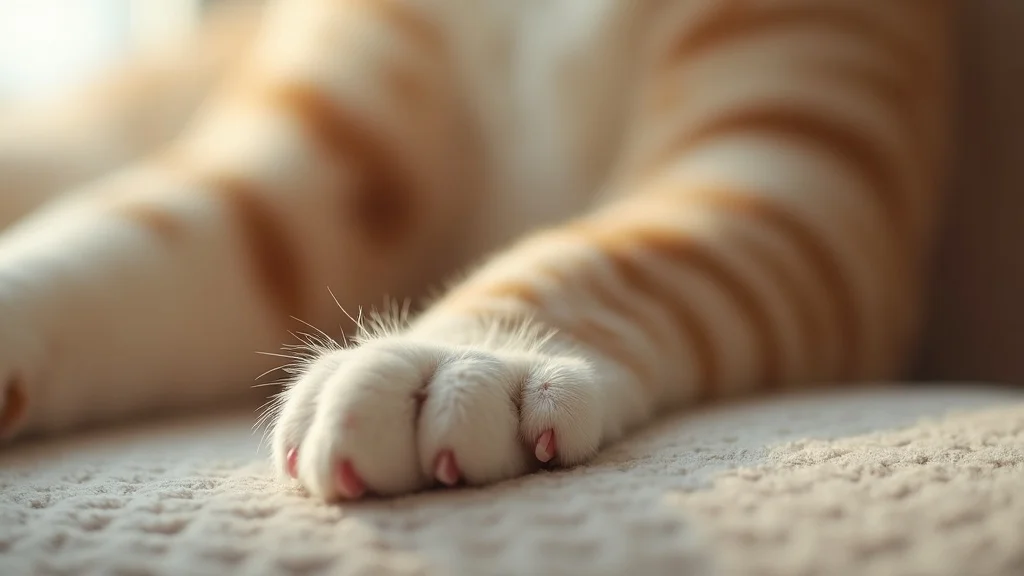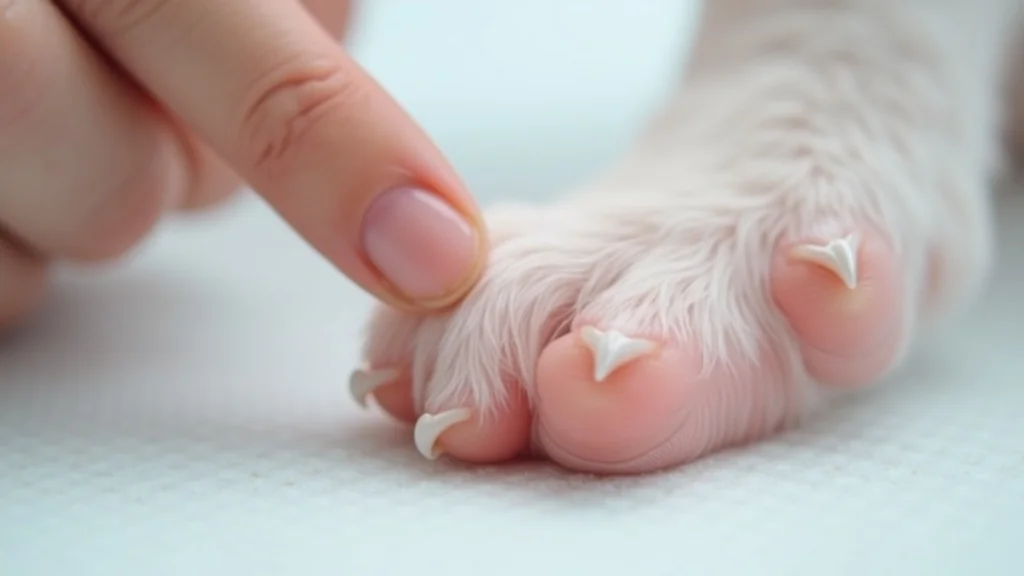Have you ever wondered if you could confidently trim your cat’s nails at home—without a scratch, stress, or fear? Many pet parents just accept scratches and stress as part of the process, but it doesn’t have to be that way. This easy-to-follow guide will answer the question, how do I trim my cat’s nails safely, and give you expert secrets for a happier, healthier cat (and less nervous nail trims for you!).
Curious About How Do I Trim My Cat’s Nails Safely? Let’s Challenge What You Think
When it comes to trimming your cat’s nails, most people are more nervous than their feline friends. You might assume that only a professional can handle cat nail care without drama, or that clipping will always end badly. In truth, with the right technique, the right tools, and a bit of feline psychology, trimming cat nails can be a safe and calm experience for both of you.
Many cat parents believe that their pet won’t tolerate having their paws handled, but the secret is in the preparation and patience. By learning to handle your pet’s paws gently and taking things slow, you can make nail trims a normal part of your routine. In just a few minutes, you’ll discover how to avoid the dreaded “quick” (the pink part that causes pain and bleed if cut), choose the best nail clippers for cats, immobilize your furry friend without triggering stress, and reward your cat for a job well done. Let's break down outdated cat grooming myths and replace them with trusted, vet-approved strategies.
“Many pet owners worry about nail trim accidents, but with the right approach, nail trimming can be safe and stress-free for both you and your cat.” – Dr. Emily Carter, DVM
What You’ll Learn About How Do I Trim My Cat’s Nails Safely
- Best practices for cat nail trimming at home
- Preventing injuries like cutting the quick
- How to immobilize a cat for nail trimming
- Choosing the right tools for safe nail trims
- Rewarding your cat to create positive experiences

Understanding Cat Nails: Anatomy and Growth Patterns
Your cat’s paws are built for climbing, scratching, and play—so understanding what’s happening beneath the fur is key to safe trims. A cat nail is not like a human nail. It’s curved, with a hard, outer shell protecting a soft, sensitive core called the quick. The quick is a pink part you might see through lighter-colored nails; it contains blood vessels and nerves. Cats have retractable claws, and on each paw, they have five nails on the front (including the dewclaw) and usually four on each back paw. The front claws typically need trimming more often because they’re less likely to wear down naturally. Knowing the difference between nail tip and quick helps you avoid pain and bleed during trims—making the whole experience more positive for both you and your pet.
Nail health isn’t just about avoiding scratches; it’s an important part of maintaining your cat’s wellbeing. Nail trims prevent snagging on carpets and reduce the risk of painful ingrown or broken claws, which are common in older cats or inactive felines. If you regularly see your cat’s nails sticking to soft furnishings, or if you hear clicks on the floor, it’s time for a trim. Understanding this anatomy and growth pattern will empower you to confidently keep your cat comfortable—and your furniture safe!
Why Cat Nail Care Matters for Your Feline's Wellbeing
Trimming your cat's nails regularly is an essential part of their health routine. Neglected claws can curl and embed into the paw pad, causing pain and possible infection. Overgrown claws also increase the risk of accidental scratches to both humans and other pets. This routine grooming helps maintain your cat’s agility, prevents joint stress, and reduces unwanted scratching behaviors. So, while it may feel daunting at first, learning to trim the tip of your cat’s nails is a loving act of care—one that enhances their comfort and strengthens your bond!
Veterinarians universally agree that maintaining short, healthy cat nails leads to fewer injuries and less anxiety for cats. Making nail trimming part of your cat care ritual also introduces opportunities for extra petting, treats, and positive attention. And when your cat isn’t stressed, you both win: your cat enjoys life comfortably, and you enjoy fewer scratches on your hands and sofa.
Cat Nail Growth Cycles and Common Problems
Cats’ nails grow at different speeds, with older cats often experiencing thicker, brittle claws. Outdoor cats may naturally wear their nails down through climbing and scratching trees, while indoor cats need trims every 2-4 weeks. Watch for signs such as nails protruding when their paw is relaxed or clicking against floors—these are clues it’s time for a trim. If left untrimmed, claws can become ingrown, leading to infection or limping. Another common issue is splitting: dry seasonal air or improper trimming can cause cracks.
Be mindful of behavioral clues—if your cat is biting or over-grooming their paws, it could indicate discomfort from their nails. Pay close attention to the dewclaw (the “thumb” claw) as it doesn’t contact the floor and is more likely to become overgrown. The more you observe your cat’s nail growth cycle and catch problems early, the easier it’ll be to keep their paws healthy and pain-free.
How Do I Trim My Cat’s Nails Safely: Setting Up for a Successful Nail Trimming Session
Preparation is the secret to a successful, smooth cat nail trimming session. Start by setting aside a quiet, well-lit area where your cat feels comfortable and secure. This could be your living room or a sun-drenched kitchen table. Gather your supplies ahead of time: nail clippers designed for cats, styptic powder in case you accidentally cut the quick, a soft towel, and some of your cat’s favorite treats. Ensure you won’t be interrupted, as patience and calm are essential to help your cat relax.
Many cats need to become accustomed to having their paws handled. Make a habit of gently touching your cat’s feet during cuddles, offering a treat when they allow you to hold their paw. This “paw training” lays the foundation for stress-free trims. Once your cat is used to the feeling, sett the mood: play calming music, keep sudden movements minimal, and have someone else available if you need help to gently hold your cat. Being prepared makes the experience easier and safer for everyone involved.
Choosing the Best Tools for Cat Nail Trimming
The right equipment makes all the difference in how do I trim my cat’s nails safely. Nail clippers designed for cats are preferred over human nail clippers because they’re shaped to accommodate the curve of a cat nail and often feature a safety guard to avoid cutting the quick. Scissor-style or guillotine-style clippers are both effective when kept clean and sharp; dull blades can crush the nail rather than making a quick, clean cut. Always keep styptic powder nearby—this stops the bleeding instantly if the quick is nicked. A small nail file can smooth jagged edges, ensuring your cat doesn’t snag nails after trimming.
Inspect your tools before each session. Cleanliness is essential to prevent infection—wipe clippers with alcohol and dry thoroughly. Keep supplies organized in a handy caddy or dedicated drawer so you’ll never have to scramble mid-trim. Taking the time to choose and maintain the best nail trimming gear leads to faster, safer, and more comfortable nail care sessions for your cat.

Creating a Calm Environment Before Nail Trim
Your cat’s emotional state is crucial for a smooth nail trim. Begin by choosing a time when your pet is naturally relaxed—after a meal or heavy play session works well for many cats. Speak in calm, gentle tones and offer reassuring pets. You may want to let your cat investigate the trimming tools ahead of time, so they’re less intimidating. Drape a soft towel over your lap and avoid any sudden movements as you handle your cat’s paws.
If your cat is particularly nervous, consider using feline pheromone sprays or diffusers in the area to create a sense of safety. For cats who resist restraint, gently wrapping them in a blanket—leaving one paw exposed at a time—can help. Consistency is key: the more calm, positive experiences your cat has with nail trims, the less anxiety they’ll feel in the future. Set yourself up for success by focusing on your cat’s comfort as much as the clipping itself.
Step-by-Step Guide: How Do I Trim My Cat’s Nails Safely at Home
- Gently handle your cat’s paws to get them used to touch.
- Expose the nail by pressing the pad to extend the nail outward.
- Identify the quick—look for the pink part, and avoid cutting the quick.
- Use clean, sharp trimmers for safety. Position the clipper perpendicular to the nail.
- Trim only the pointed tip of each nail. Never clip near or into the quick.
- Reward your cat with treats and praise after every successful nail trim.

Nail Trim Safety: How to Avoid Cutting the Quick
The biggest concern most cat parents have during a nail trim is accidentally cutting the quick—the pink, sensitive part of the nail containing nerves and a blood vessel. Slicing into the quick will cause your cat pain and bleed, leading to fear of future trims and potential infection. For cats with light-colored nails, the quick is usually easy to spot. For those with dark nails, only trim small amounts at a time and watch for a chalky white ring, which signals you’re close to the quick.
Always make several small, careful cuts rather than a major snip. The safe zone is the clear, hooked tip of the nail—trimming just this part reduces the risk of injury. Brighter lighting and a slow pace are your best tools for avoiding cutting the quick. If you’re unsure, trim less rather than more; you can repeat the process more frequently, but you can’t undo a painful cut. A calm approach and vigilant observation are the foundation of safe cat nail care.
How to Spot the Quick in Cat Nails and Why It’s Important
Spotting the quick is vital for painless nail trims. Hold your cat’s paw pad gently and extend the nail. In clear or white nails, you’ll see a pink core (the quick) inside the nail—keep blades far from this area. With dark or black nails, shine a small flashlight underneath to reveal the rough boundary of the quick. Always avoid cutting the quick, as it contains sensitive nerves and blood vessels; cutting here will make your cat anxious about future trims and may require first aid.
If you can’t tell where the quick ends, err on the side of safety. Even professional groomers sometimes trim less to make sure they don’t cause pain. Your cat will thank you for your caution! As you become more experienced, you’ll develop an eye for the perfect spot to trim the tip safely and easily.

First Aid Tips: What to Do If You Accidentally Cut the Quick
If you accidentally cut the quick and cause bleeding, stay calm. Immediately dip the nail into styptic powder (or gently press a styptic pencil to the nail) to stop the bleeding. If you don’t have styptic products, firmly press a clean tissue or gauze to the nail until bleeding ceases. Keep your cat calm and prevent them from licking the wound, as this can delay healing. Most quick nicks heal quickly if treated promptly, but monitor for signs of infection (redness, swelling, or prolonged bleeding) and contact your vet if you’re concerned.
Don’t scold or panic—reassure your cat, offer a treat, and take a break before trying again. Accidents happen, even to the pros. The key is to minimize stress and turn it into a learning experience. This will help your cat remain willing to participate in future nail trims.
Pro Tips: Immoblizing Your Cat for Nail Trimming Without Stress
Immobilizing your cat safely is crucial for a smooth nail trim. The goal is to gently hold your cat still without causing fear or resentment. For most cats, wrapping them snugly in a towel (the “kitty burrito technique”) with one paw exposed is highly effective. This keeps both you and your feline safe, reducing the chance of sudden jerks or scratches. For particularly energetic cats, enlist a helper to gently hold the cat, using calm, reassuring hands on the shoulders or back to keep your pet steady but secure.
If your cat is especially nervous, try positive associations. Drape your cat in a soft towel during cuddle time, and offer treats when they stay calm. Over time, this helps reduce negative reactions when the towel appears for grooming. Practice makes perfect: regular, non-trimming handling helps cats get used to having their paws handled and associating these moments with affection, not apprehension.
Techniques for Calming and Immobilizing Cats Safely
A soft voice, gentle touch, and steady pace do wonders for calming cats before a nail trim. The towel wrap technique (kitty burrito) is a staple among veterinarians and groomers. Place your cat on a towel, fold it snugly around the body with only one limb exposed, and continue to speak softly as you hold the cat. Light, even pressure reduces anxiety and helps avoid startling your pet. If your cat becomes upset, take a break and try again later—never force the issue.
Other calming aids include pheromone sprays or diffusers in the grooming area, as well as familiar objects like your cat’s favorite blanket. It’s crucial to build trust: regular, low-stress paw handling sessions (even without actual trimming) make each future nail trim easier and less intimidating for your feline friend.

When to Ask a Professional for Help with Nail Trimming
If your attempts at home are consistently met with fear, aggression, or if you find it impossible to avoid cutting the quick, don’t hesitate to contact a professional groomer or veterinary clinic. Some cats, especially older cats with health conditions, may need sedation or specialized handling for safe trims. Don’t struggle alone—your vet can demonstrate techniques, recommend better tools, or even clip your cat’s nails for you. The goal is always a stress-free, pain-free experience for your feline, so prioritize safety and comfort above all.
Seeking professional help also makes sense if you notice signs of infection, injury, or abnormal nail growth. A skilled pro can tackle tough cases and offer tips tailored to your unique kitty, helping you build confidence for future at-home trims.
Reward Your Cat: Making Nail Trimming a Positive Experience
Transforming your cat’s nail trim from a feared event into a positive one hinges on rewarding your cat. After each successful step—whether it’s letting you hold the paw, a single nail trimmed, or a finished manicure—shower your cat with treats, extra petting, and praise. This positive reinforcement builds trust, teaching your feline that good things happen when their nails are trimmed.
Use high-value treats your cat doesn’t get at other times and praise in a cheerful voice. Consistency is key: over time, your cat may even look forward to grooming sessions! Think of these moments as a chance to bond, not just a chore to power through. With patience and lots of positive reinforcement, nail trims can become a routine part of your cat’s life—minus the drama.
Treats and Praise: Reinforcing Good Nail Trim Behavior
The phrase reward your cat isn’t just about giving a treat—it’s about making the entire process enjoyable. After trimming each nail (or even after just handling the paws calmly), offer small bits of a favorite food, a head scratch, or a few minutes with a beloved toy. Immediate rewards help your cat make the connection between nail trims and positive experiences. If you skip this step or only reward after the full trim, you may miss out on reinforcing the right behavior.
Tailor your rewards to your cat’s preferences—some cats like food, some prefer cuddles. For exceptionally nervous cats, even a break and a change in scenery can be a reward. Steady encouragement and positive experiences are crucial for how do I trim my cat’s nails safely, making you both look forward to next time.

Tools and Gear: Best Nail Clippers, Styptics, and More
| Tool | Features | Recommended Use |
|---|---|---|
| Cat nail clippers | Curved blades, safety guard | Home trims |
| Styptic powder | Stops bleeding | Quick nicks |
| Nail files | Finishing touch | Smooths edges |
How Often Should You Trim Your Cat’s Nails for Optimal Health?
The right trimming schedule depends on your cat’s lifestyle and age. On average, most indoor cats benefit from nail trims every 2–4 weeks. Outdoor cats, who naturally wear down their nails, may need less frequent care, but it’s still important to check regularly. Kittens and young cats may need more frequent nail trims as they adjust to home environments, while older cats with less activity benefit from consistent maintenance to prevent overgrowth.
Observing your cat’s nails and routine behavior is the best indicator. If nails are snagging on carpets, clicking on hard floors, or if you notice your cat biting or licking their paws, it’s time for a trim. Clipping regularly not only prevents injuries but helps your cat become comfortable with the process—which is key to long-term health and happiness.
Guidelines for Indoor vs. Outdoor Cats
Indoor cats are more likely to require regular trims since scratching posts and soft furnishings usually aren’t enough to keep their nails short. Aim for every 2–4 weeks, checking both front and back paws. In contrast, outdoor cats who frequently climb and scratch may naturally keep their nails at the right length—but monitor them for splits, cracks, or signs of embedded claws, especially in older cats.
Remember, even if your cat is mostly outdoors, annual or semi-annual vet check-ups should include a quick nail inspection to spot potential problems early.
Signs Your Cat Needs a Nail Trimming
Look for clear cues: nails visible when your cat’s paw is resting, clicking sounds on hard surfaces, or your cat getting stuck on blankets. If you see any curved or thickened nails, especially on the dewclaw, it’s time for a trim. Excessive paw licking, biting, or limping can be signs of discomfort caused by overgrown claws. Proactive care prevents bigger, more painful issues down the road.
Stay alert to changes in walking, hiding paws, or hesitance to jump or play—these may indicate nail pain. With regular attention, you’ll keep your cat well-groomed and happy, while enjoying less scratched furniture as a bonus!
This video shows a veterinarian guiding you through each step, including how to hold the cat’s paw, spot the quick, and reward your cat after a successful trim. Seeing the process in action builds your confidence—so hit play before your next grooming session!
People Also Ask: How to Trim a Cat's Nails That Won't Let You?
Answer: How to Trim a Cat's Nails That Won't Let You
If your cat refuses to allow nail trims, start by gradually desensitizing them—gently handle their paws daily, offer treats, and praise calm behavior. Use a towel wrap to immobilize your cat if needed, keeping one paw exposed at a time. Break the process into small steps: trim one or two nails per session and stop if your cat becomes anxious. Don’t force the issue; instead, make each interaction short and positive. If all else fails, consider enlisting a helper or your veterinarian for guidance and support.
People Also Ask: Are You Supposed to Trim Indoor Cat's Nails?
Answer: Are You Supposed to Trim Indoor Cat's Nails
Yes, indoor cats rely on nail trims to keep their claws comfortable and prevent overgrowth. Unlike outdoor cats, they lack natural surfaces that wear nails down, making regular trimming vital. Keeping your indoor cat’s nails short protects your furniture and ensures your pet is pain-free. Make nail trimming as routine as brushing or feeding, starting when your cat is a kitten if possible for easiest results.
People Also Ask: How to Immobilize a Cat for Nail Trimming?
Answer: How to Immobilize a Cat for Nail Trimming
To safely immobilize a cat, use a towel wrap (“kitty burrito”) with just one paw exposed for trimming. Hold your cat gently but securely in your lap, using even, gentle pressure. Enlist a helper if needed to support your cat’s body, keeping movement to a minimum. Always prioritize your cat’s emotional comfort and stop if they become distressed—forced restraint can foster fear of future trims.
People Also Ask: How Do I Trim My Cat's Nails at Home?
Answer: How Do I Trim My Cat's Nails at Home
Start by familiarizing your cat with paw handling, then use a well-lit area and sharp nail clippers designed for cats. Press the paw pad to extend the nail, identify the quick, and clip just the pointed tip. Trim a few nails at a time, giving praise and treats for good behavior. If nervous, wrap your cat in a towel, and never hesitate to pause and finish later. Patience, practice, and positive reinforcement will make home nail trims easier with each session.
Frequently Asked Questions About How Do I Trim My Cat’s Nails Safely
- What if my cat fiercely resists nail trimming? – Try desensitizing your cat to paw handling slowly and use high-value treats. If your cat remains fear-aggressive, consult your veterinarian for specialized approaches or professional grooming help.
- Can I use human nail clippers for my cat? – Human nail clippers can crush or split cat nails. It’s best to use clippers specifically designed for cats—they offer better control and safety features to avoid cutting the quick.
- How do I recognize nail trim anxiety in my feline? – Signs include panting, hiding, vocalizing, swatting, or aggressive grooming of the paws. Stop, offer comfort, and resume the process later. Positive associations are key to reducing anxiety.
- What’s the best age to start trimming my kitten’s nails? – You can begin handling and gently trimming a kitten’s nails as early as 6–8 weeks. Early and positive experiences foster a lifetime of easy nail care.
Key Takeaways: How Do I Trim My Cat’s Nails Safely
- Patience and gentle restraint are crucial to how do I trim my cat’s nails safely
- Always avoid cutting the quick to minimize pain and injury
- Positive reinforcement, such as rewarding your cat, encourages cooperation
- Regular nail trims protect both you and your feline from accidental scratches
Stay Updated on Pet Care: Subscribe to PawPress for More Tips
Want more tips, stories, and pet care guides delivered straight to your inbox? Join our monthly PawPress newsletter and stay in the loop with the latest for your furry friends. 🐾 Subscribe now — your pets will thank you!
To enhance your understanding of safely trimming your cat’s nails, consider exploring the following resources:
-
“How To Cut Cat Nails”: This comprehensive guide from PetMD offers step-by-step instructions on holding your cat, exposing the nail, and making precise cuts to avoid the quick. (petmd.com)
-
“How to Trim a Cat’s Nails”: VCA Animal Hospitals provides detailed advice on selecting appropriate nail clippers, safely restraining your cat, and techniques to minimize stress during the trimming process. (vcahospitals.com)
These resources offer expert insights and practical tips to ensure a safe and stress-free nail trimming experience for both you and your feline companion.
 Add Row
Add Row  Add
Add 




Write A Comment